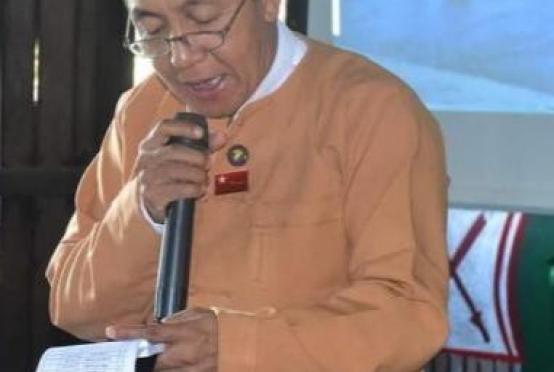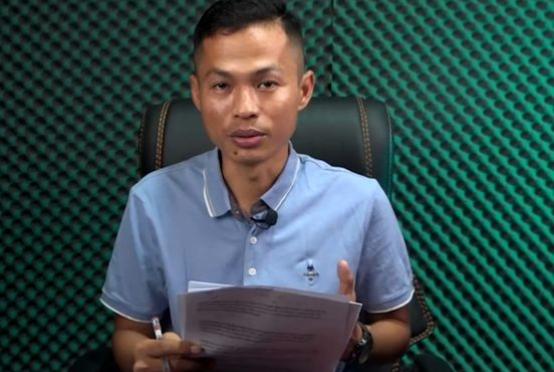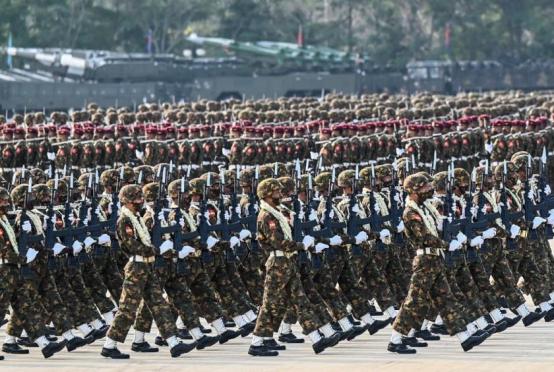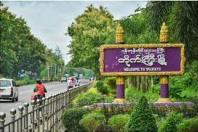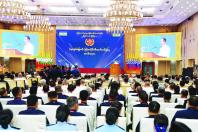
The root cause of inserting the prohibition “non-secession” does not mean that it does not believe national brethren as criticized by some organizations. I would like to say it aims to ensure full guarantee in the long run, to build trust and to join hands with them on the path of eternal peace without doubt, said Senior General Min Aung Hlaing.
The remarks of the military chief came from the special meeting between the Government and Nationwide Ceasefire Agreement Signatory Ethnic Armed Organizations at the third anniversary of signing the Nationwide Ceasefire Agreement (NCA) at Shwe San Ein Hotel in Nay Pyi Taw on October 15.
The remarks of the State Counsellor came from the special meeting between the Government and Nationwide Ceasefire Agreement Signatory Ethnic Armed Organizations at the third anniversary of signing the Nationwide Ceasefire Agreement (NCA) at Shwe San Ein Hotel in Nay Pyi Taw on October 15.
Today is the third anniversary of the Nationwide Ceasefire Agreement-NCA reached between the Government of the Republic of the Union of Myanmar and ethnic armed organizations-EAOs. First and foremost, I would like to extend greetings that may all representatives of NCA signatory ethnic armed organizations and officials who are attending the retreat have mental well-being and enjoy peace and tranquility, said Senior General Min Aung Hlaing.
The nationalities of the country know that the current anniversary is more signifi cant than the anniversaries of the previous two years both in character and essence. I have noticed greater aspirations and interest for peace of the national people. At this moment, we are gathering here, serving the historic duty to fulfi ll the wish of the peaceloving people. We of the Tatmadaw are exerting utmost physical and intellectual efforts to shoulder the historic duty well and restore eternal peace and strengthen democracy, said Senior General Min Aung Hlaing.
At the previous NCA signing ceremonies, there were speeches and dinner, which were only a little bit noteworthy than a normal commemorative ceremony. But this year is more signifi cant, with the involvement of follow-up talks. We are going to gather greater momentum for the peace process. I have already explained the resolution of the Tatmadaw to complete the peace process in 2020 in my address at the opening ceremony of the previous Union Peace Conference. Here, I would reiterate that the Tatmadaw will present the eternal peace to the people who are desirous of it after fully realizing the resolution. The government is working under the goal of adopting more basic principles by holding the conference for three times in 2018 and 2019. The previous conferences have already adopted 51 basic principles for political, economic, social and land and environment sectors, and they have been formed as parts of the Union Agreement. Those principles can be adopted thanks to the benefits of NCA and the adherence to its roadmap. It is not an easy task to reach accords among the warring factions through faceto- face discussions. It is the result of collective talks under the spirit of oneness. Basic principles should be adopted in accordance with the 11-point fundamental rules of the Chapter I of the NCA. So, I would suggest that fundamental rules must be thoroughly understood, said Senior General Min Aung Hlaing
The fi rst point is an accord which is a clear explanation of the way the Union, based on democracy and federal system, will be established, as it is the cornerstone of the current peace process and aspired much by the national races. It has three objectives, three basic factors and a three-point guarantee which must be followed compulsorily. An accord has been reached on building the Union, based on democracy and federal system, in accordance with the results of the political dialogue. The three objectives are non-disintegration of the Union, non-disintegration of national solidarity and perpetuation of sovereignty which in reality are “Our Three Main National Causes.” The foundation is formed with deterrent principles—liberty, equality and justice. Democracy, equity and self-determination are guaranteed. All must aware of the fact that the said guarantees can be realized through the strict observance of Our Three Main National Causes. Now I will deal with “nonsecession” which is said to be a diffi cult issue at the conference. Our Three Main National Causes is to be always kept in the fore at the political dialogue held after abandoning thearmed struggle line. So, it needs to realize the issues that go against the objectives — non-disintegration of the Union, non-disintegration of national solidarity and perpetuation of sovereignty – must be avoided at the very start of the talks. Section 10 of the 2008 Constitution of Myanmar has clearly stated that no part of the territory constituted in the Union shall ever secede from the Union, said Senior General Min Aung Hlaing.
So, the word “non-secession” is a term or assurance truly required for the eternal peace. The anniversary sessions of the Peace Conference, including the present one is initiated by the peace overture extended by the administration of President U Thein Sein in 2011. At the dialogue with EAOs according to the “The Invitation for Peace Talks” issued on 18 August 2011, the peace processes began only after the initial accord to accept Our Three Main National Causes and to stay away from raising the issue of secession. Therefore, it doesn’t need to dispute whether to insert the agreement “non-secession”. I would like to say that the agreement must be inserted in line with the principles of NCA and the principles of the Constitution 2008. Law, rules and disciplines are defi ned as “exhortation” and “prohibition”. The Union Agreement in implying the law mentions exhortation and dos. So also, only then, will it be endowed with descriptions on prohibitions and don’ts. The root cause of inserting the prohibition “non-secession” does not mean that it does not believe national brethren as criticized by some organizations. I would like to say it aims to ensure full guarantee in the long run, to build trust and to join hands with them on the path of eternal peace without doubt. The Union System or the Federalism is an ideology of sharing power and sovereignty to unite diverse regions, states, ethnics and tribes, said Senior General Min Aung Hlaing.
It is visible that the Federalism cannot be taken as defi nite, and practising of such system cannot be the same in various countries. The Union System can be practised under the Coming Together Federalism, the Putting Together Federalism and the Holding Together Federalism. Our country is a family which had been practising the Holding Together Federalism during the monarchial era before falling under the British colonial rule. At a time when King Thibaw, the last dynasty of Myanmar, was captured by British, 500 followers led by the person waited at Phayagyi of Mandalay for taking back the king from British. He was a Shan Chieftain namely Nyaungshwe Chieftain U Saw Maung. Therefore, British colonialists worried about unifi cation between Bamar and ethnics. British practised various administrative systems and laws such as the Shan States Act of 1888, the Kachin Hill Tribes Regulation-1895, the Chin Hill Regulation-1896 for prevention of the unifi cation in order to cause divisiveness between ethnic regions and the central region of Myanmar. Diarchy ruling system which was practised from 1921 to 1937 did not accept participation of ethnic regions, and the legislative council set the ratios for those elected from general constituencies, those from Indians, Kayin ethnics, half-breed British citizens and British citizens with the purpose of disintegration in racism. It can be seen that British colonialists arranged practice of divide-and-rule system in the mainland of Myanmar without satisfaction to instigate the hilly and plain regions. The 91-department administration in Myanmar divided the general constituency, Kayin ethnic constituency, Indian citizen constituency, half-breed British citizen constituency, European citizen constituency and chettyar association constituency join the Lower House. Other ethnics did not participate in it separately, said Senior General Min Aung Hlaing.
Edited by Win Htut

